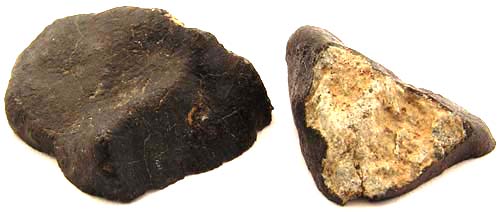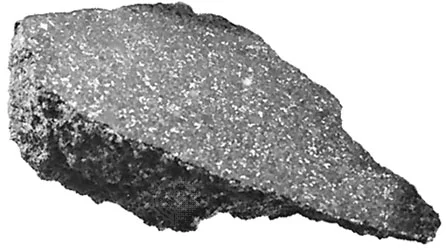Meteorites vs Lookalikes: A Simple & Digestible Guide to Identifying Meteorites
- Kara Thornton
- Feb 23, 2022
- 7 min read
Updated: Mar 4, 2022
Think you've found a ~space rock~ but not sure how to identify it? Here you'll find a comprehensive guide to tell you whether you're holding a space artifact, or piece of trash.
To find out how on earth we got here click the button below:
Basically if you've never tried to identify a meteorite verses an 'earth rock you may be surprised at how much information is out there. A lot of that information is full of intimidating geological terms and principles that have been known to spark downward spirals that will have your head swimming. But fear not! I've swam enough for the both of us. So let me break this down to make it more digestible for us folks less familiar with geology and rock identification.
First off: I can’t emphasize this enough…
Don’t get your hopes up!
From the get-go I advise you to... *and please don't hate me for saying this*... think of this as a journey, not a destination. Luckily I love nature and respect and greatly appreciate the thorough process of identification. Therefore, last weekend when I started researching what I thought could be a meteorite, I thoroughly enjoyed the process... even without results of wealth, though some cash earnings obviously would’ve been ~SUPER COOL~ after all this!!! 😑 Click the button below to watch our youtube video about the experience:
As you search the web you’ll quickly learn most presumed-meteorites are actually earth rocks of some sort. To help my Mobile Mushroom fam and any fellow rock-hounders out there, here is a step-by-step guide for if you ever think you’ve come across a meteorite:
Here are the 3 Main Actions to Take:
1. Do your own research
- Y’all this is the bare minimum! Be sure to become familiar with the subject and do your own tests before moving forward or jumping to any conclusions. I've made this first step easy with helpful, curated information and simple techniques for eliminating lookalikes below.
2. After you’ve thoroughly researched at least the basics, do some thread digging
- I’m talkin’ reddit, geology blogs, Facebook groups etc. There are multiple Facebook groups specifically made to help ID meteorites vs earth rocks. But, before you post, be sure to take a look at previous inquiries, read comments, and browse photographs.
3. At this point if you’re still thinking your rock could be a space rock and you've exhausted all other options, reach out to experts in the field
- This could start with those meteorite-identifying Facebook groups like this one: Is it a Meteorite? but if you’ve educated yourself enough about possible lookalikes, tell-tale characteristics, and still aren’t convinced it’s not a meteorite reach out to your local Geological Survey Agency. Consider visiting or contacting a local college or university geology department. I was fortunate enough to be the Tucson, AZ area which is surrounded by local Rock Shops, lapidary artists, rock enthusiasts, and geologists.
HOT TIP: If you have absolutely no prior knowledge about meteorites, a very helpful resource I wish I'd known about before is Washington University in St. Louis' page titled 'Some Meteorite Information' where you can learn about the first steps to take, see side-by-side comparisons, and even learn where most meteorites are found on the earth! |
Do the Research: Understanding Meteorites
Meteorites can be classified in 3 main types: Stony, Iron, and Stony-Iron
Let’s take a look at their characteristics and subgroups…
Stony Meteorites: rocks, mainly composed of silicate minerals (wiki) these are the most abundant type of meteorite found
Iron Meteorites: consist overwhelmingly of an iron–nickel alloy known as meteoric iron. Most iron meteorites originate from the cores of small planets that were once molten (wiki)
Stony-Iron Meteorites: contain large amounts of both metallic and rocky material and are the most rare form of meteorite, comprising only 1% of all found meteorites (wiki)

- Pallasite: consist of centimeter-sized olivine crystals of peridot quality in an iron-nickelmatrix (wiki)
- Mesosiderites: consist of about equal parts of metallic nickel-iron and silicate (wiki)
No matter the type, here are 3 universal tests to start with to quickly eliminate any lookalikes:
1. Is it heavy/dense?
- Basically this is something you just have to “feel” based on the specimen’s size. This can also help rule out any volcanic pumice stone as it is extremely light weight, or *porous* which is an absolute No-Go for meteorites!
2. Does it react to a magnet?
- Because some meteorites are more magnetic than others, a tip is to hang your magnet from a string and hold it next to the specimen as you rotate it to better recognize any magnetic attractions.
3. Does it leave a brown residue on an unglazed ceramic surface?
- Got a ceramic tile laying around? Or maybe even a mug? Find the unglazed portion of a piece of ceramic material (preferably white/light-colored for best results) and scrape the rock against the grainy material. What color does it leave behind? If it’s brown things are looking good!
If your rock has passed the tests above, next you should consider the physical characteristics. A magnifying glass can be helpful for this step.
Above photos & information provided by aerolit.org
Here I'll provide what I wish I had when I started all this: A gallery of photos showing different meteorites. I'm a visual learner so absorbing all of this information through descriptions was hard for me, so here's a gallery to help. Each photo is linked to its original source so you can view the articles of origin.
A large number of these images came from a site that also provides some great side-by-side comparison photos for meteorites vs. lookalikes here.
Now that we've familiarized ourselves with visuals, here is a list of characteristics I found helpful that describe meteorites versus 'meteor-wrongs' provided by the University of New Mexico's Meteorite Museum webpage:

If your rock lacks characteristics listed under 'Meteor-wrongs' we can move on to defining some terms listed in the Meteorite column:
- Fusion Crust: This feature is defined by our friends at Aerolite as "A thin black rind, some times shiny, sometimes matte black, which forms while falling meteoroids are super-heated in the atmosphere." To the right is an example from Washington University STL's page titled 'Some Meteorite Information' of a recently fallen stone meteorite from Australia. Look closely at the bottom and top right to catch a glimpse of the meteorite's much lighter-colored interior. See more photos of fusion crusts provided by WUSTL's here. In discussing fusion crusts, WUSTL goes on to claim:
A fusion crust is the most characteristic feature that distinguishes a meteorite from from a plain old Earth rock. If a rock does not have a fusion crust and does not contain iron-nickel metal, then there is no reason to suspect that it is a meteorite, regardless of what other meteorite-like features it may have.
- Regmaglypts: These essentially look like thumbprints. Here's a great example of regmaglypts among 3 meteorites at different ages from aerolite.org
- Chondrules: These appear as small grainy bits and classify a meteorite as a Chondrite which is the most common type of meteorite, making up about 86% of all meteorites (Wiki). Be sure not to confuse this characteristic with igneous volcanic rocks like I did! See the difference below:
- Note that any surface holes or 'vesicles' are a quick indicator that is it NOT a meteorite. Vesicles are caused by gasses evaporating and are not seen in meteorites (more on this below). This is something I wish I could've found easily in my research. This tip is VERY helpful in identifying slag, which is the material most commonly confused for meteorites. When doing my own research the term 'holes' seemed a bit vague to me considering the diversity of textures, so here is an exact example:

Spotting these holes, termed vesicles, in the dense magnetic material you've found is the easiest way to identify the material as slag.

Mike Conway of the Arizona Geological Survey describes it simply:
"This is slag - an iron-rich byproduct of smelting copper. As slag cools gases escape leaving behind telltale half-spheres. We do not see vesicles in meteorites."
I found it interesting that in all the 'How to Identify a Meteorite' articles I'd read none of them had mentioned this simple tidbit. As mentioned previously, most rocks suspected of being meteorites are in fact slag and sport an abundance of these vesicles to prove it.
Here is a close-up look at other physical characteristics of the SLAG I found that is NOT A METEORITE:
And in identifying slag, this brings us to...
What could it be, if not a meteorite?
Here are a few examples rocks/materials of commonly mistaken for meteorites
- Slag: a byproduct of copper smelting
- Volcanic Rock or Basalt (igneous rock)
- Obsidian (natural glass rock)
- Hematite
- Tektite: now hang on! It could be you’ve found something meteorite-adjacent…
Tektites: small, pebble-like glassy objects of Earth material that have been melted by meteorite impact, splashed up into our atmosphere, and fallen to Earth again under gravity.(Australian Museum). Now don't be fooled by any source that tells you these are never magnetic as research continues on their magnetic properties as some samples are known to be slightly reactive to magnets (see studies like this one).
So keep in mind we discussed that meteorites do not have "holes" but looky here.... Tektites are known to have "pits." According to Meteorite.com:
"Tektites are not usually smooth, they are usually pitted or grooved or a combination of both. More often than not they have a bald spot which is smooth."

Interested in learning exactly how to identify tektites? This Tektite Info website is an incredible resource with an array of comparison photos, tips and tricks, and even quizzes!
All this to say, it can be challenging trying to identify practically anything in nature, but it is an important and rewarding experience.
Have any specific questions? Leave us a comment or message us and I'll be happy to help as best I can. Happy hunting!
Sources:
*Special thanks too 'sweet sweet' Mike Conway of the Arizona Geological Survey*
.png)















































Comments